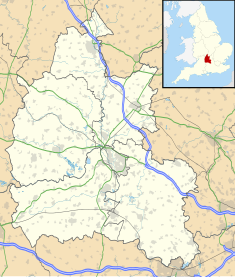| Rollright Stones | |
|---|---|
 Part of the King's Men stone circle, one of three monuments at the site | |
| Type | Dolmen, Stone circle and monolith |
| Location | Oxfordshire |
| Coordinates | 51°58′32″N 1°34′15″W / 51.9755532°N 1.5707995°W |
| Official name | The Rollright Stones |
| Designated | 18 August 1882 |
| Reference no. | 1018400 |
The Rollright Stones are a complex of three Neolithic and Bronze Age megalithic monuments near the village of Long Compton, on the borders of Oxfordshire and Warwickshire. Constructed from local oolitic limestone, the three monuments, now known as the King's Men and the Whispering Knights in Oxfordshire and the King Stone in Warwickshire, are distinct in their design and purpose. They were built at different periods in late prehistory. During the period when the three monuments were erected, there was a continuous tradition of ritual behaviour on sacred ground, from the 4th to the 2nd millennium BCE.[1]
The first to be constructed was the Whispering Knights, a dolmen that dates to the Early or Middle Neolithic period. It was likely to have been used as a place of burial. This was followed by the King's Men, a stone circle that was constructed in the Late Neolithic or Early Bronze Age; unusually, it has parallels to other circles located further north, in the Lake District, implying a trade-based or ritual connection. The third monument, the King Stone, is a single monolith. Although its construction has not been dated, the dominant theory amongst archaeologists is that it was a Bronze Age grave marker.
The British philologist Richard Coates has proposed that the name "Rollright" is from the Brittonic phrase *rodland rïx 'wheel enclosure groove', where *rïx 'groove' refers to a narrow valley near Great Rollright and *rodland 'wheel enclosure' refers to the King's Men circle.[2] By the Early Modern period, folkloric stories had developed about the Stones, telling of how they had once been a king and his knights who had been turned to stone by a witch. Such stories continued to be taught amongst local people well into the 19th century. Meanwhile, antiquarians such as William Camden, John Aubrey and William Stukeley had begun to take an interest in the monuments. Fuller archaeological investigations were undertaken in the 20th century, culminating in excavations run by George Lambrick in the 1980s. The site is listed by Historic England as a scheduled monument and was first designated in 1882.[3]
In the 20th century, the stones became an important site for adherents of various forms of Contemporary Paganism, as well as for other esotericists, who hold magico-religious ceremonies there. They also began to be referred to more widely in popular culture, being featured in television, literature, music and art.
- ^ Fagan, Brian M. (2006). From Stonehenge to Samarkand: an anthology of archaeological travel writing. Oxford University Press. p. 6. ISBN 0195160916.
- ^ Coates, Richard (2004). "Invisible Britons: the view from linguistics". University of Sussex. p. 7. Archived from the original on 3 March 2016. Retrieved 27 October 2016.
- ^ Historic England. "The Rollright Stones (1018400)". National Heritage List for England. Retrieved 12 January 2021.
